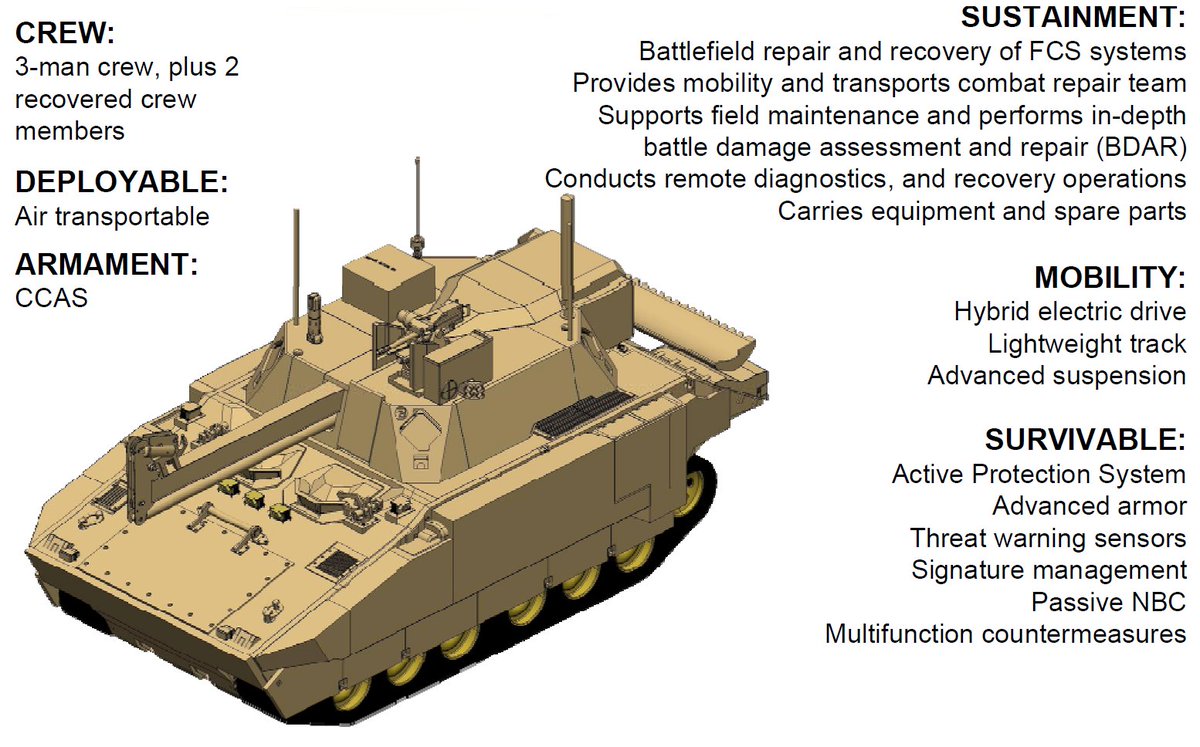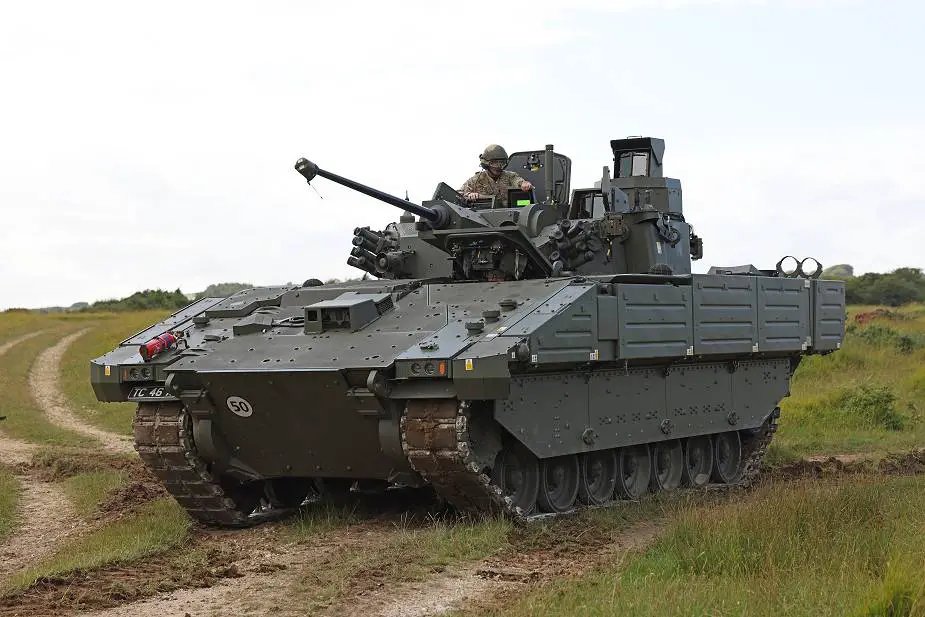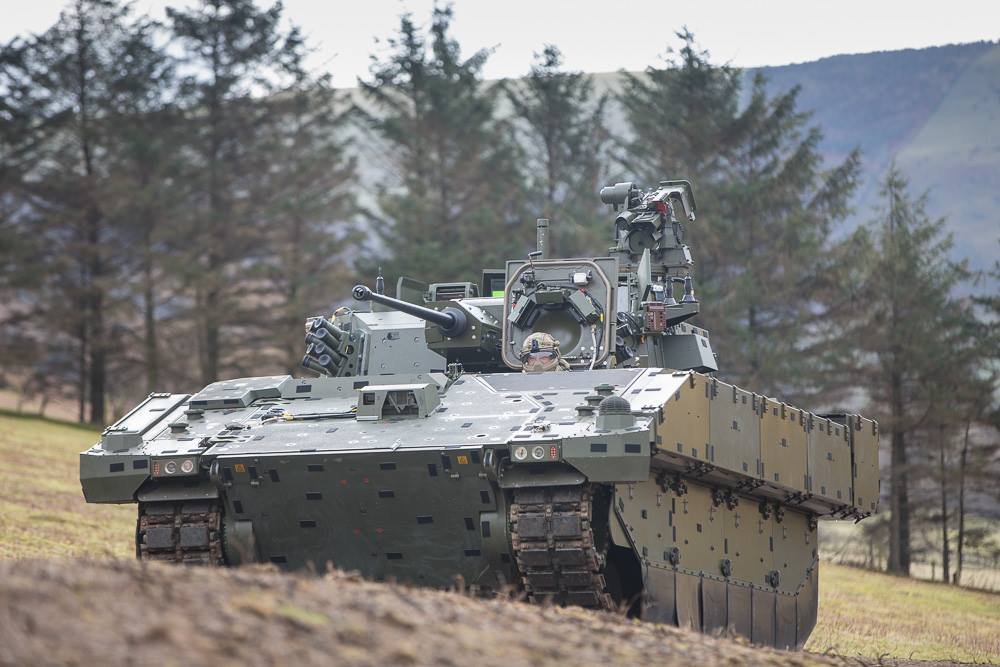A brief summary🧵of the Manned Ground Vehicle (MGV) element of the aspirational US Army Future Combat Systems (FCS) programme. A bit of a "what they almost got" for the US Army of the late 90s and early 00s. 

MGV was a common family of AFV that were bold in their vision - baseline 24 ton hull (later upped to c.30t) with hybrid drive & CRT track, loads of data & sensor fusion, a lot of automation (most variants were 2-man crews), with less passive armour and more smart solutions. 

A few more details of the core base platform that the family would build on. Lots of bold capabilities that many 2020s AFV still lack, and all with the strategic benefits of a single common platform across an entire Army fleet, which are substantial. 

As mentioned, survivability was being sought not by heavy and bulky passive armour, but by signature management systems, APS, an applique B kit armour (incl. an underbody V-belly addon), and keeping crew to 2 in the hull for most variants. 

By 2020s standards where 🇺🇸 XM30 is fielding 50 mm and many users mounting 40 mm (incl. 🇬🇧/🇫🇷 40 mm CT), it wasn't desperately exciting, with the 30 mm MK44 Bushmaster II selected. It was an uplift over Bradley's 25 mm and was in part selected to minimise weight and size, though




The variants that made up the MGV family, then:
XM1201 Reconnaissance and Surveillance Vehicle (RSV) was the replacement for M3 Bradley, with all the modern trappings of a recce AFV, including a sensor mast, small UGV and two UAVs. 

XM1202 Mounted Combat System (MCS) was the tank variant, still mounting 120 mm (using the composite XM360 gun with autoloader) rather than a larger calibre, with direct and indirect fire modes using smart ammunition. Crew would still be just two people in the hull 

XM1202 would fire XM1111 Mid-Range Munition, a 120mm beyond line of sight (BLOS) family that would come in 2 version - MRM-KE and MRM-CE, kinetic penetrator and HEAT respectively. Both were boosted by rocket motor and guided to target with autonomous or semi-active laser guidance 

XM1203 Non-Line of Sight Cannon (NLOS-C) was the 155 mm artillery variant, with a high RoF and boatloads of automation from the XM2001 Crusader. (old thread here for more on the Crusader efforts that never came to be, especially the reload vehicle: )

https://x.com/JonHawkes275/status/1386993067614420994

The NLOS-C was one of the few examples that saw real steel tested extensively, with 8 demonstrators having completed a fair amount of live fire testing in 2008/9 prior to its cancellation. NLOS-C actually outlived the MGV effort due to its maturity, but only by a few months.






XM1204 Non-Line of Sight Mortar (NLOS-M) was the 120 mm mortar, firing a breech loading weapon operated by 2 crew, with a further 2 crew (driver/commander) in the front of the vehicle. Oddly lacking in automation compared to the NLOS-C, and felt like it lacked a bit of ambition. 

Given how aspirational the rest of FCS was, its weird NLOS-M was so average in its spec. Compare to a modern system like NEMO or better yet AMOS (both of which have been around some considerable time now!) and it just feels an odd one out.






XM1205 Field Recovery and Maintenance Vehicle (FRMV) is the ARV of the family (ARV and AEV are always the best variants), with a crew of 3 plus space for 3 passengers from recovered vehicles. Turret mounted crane and a bunch of the usual winches and gear for recovery and repair.




XM1206 Infantry Carrier Vehicle (ICV) is the IFV of the bunch, actually very closely aligned to the XM1201 RSV just with less recce gear and more dismount capacity, which was 9-soldiers plus the 2-person crew. 

Dogged determination to get a 9-person capacity is part of what would drive relentless size problems of US IFV efforts throughout the 90s and early 00s, with the subsequent GCV programme finally giving up and cancelling efforts with undelivered prototypes sat at around 85 tons.






XM1207 Medical Vehicle–Evacuation (MV-E) and XM1208 Medical Vehicle–Treatment (MV-T) are the standard pair of medical variants, one for purely extraction and immediate life support, the latter with more equipment for deeper treatment. Both with crew of 4 + 4 patients. 

XM1209 Command and Control Vehicle (C2V) is, again, a fairly standard variant - providing space for 2 crew plus 4 staff officers to conduct C2 duties. Lots of fancy C4 kit to fuse data across formations, and generic references to a few hosted UAVs for situational awareness 

Ultimately it was all cancelled due to changes in priorities as a post- 9/11 US Army evolved, and today there has still been no collective or partial acquisition of any of these capabilities, with the Bradley, Abrams and Co. all still in service, but at least several... 

...susbtantial upgrades along since then. The main thrust of effort since FCS' MGV has been to keep trying to replace Bradley, which led from FCS MGV through the GCV, NGCV, OMFV, and now XM30 MICV efforts.
American Rheinmetall and GDLS are in the final running for XM30 following a downselect in June last year, will be interesting to see if c.7th time is the charm for the US getting a new IFV... /end




• • •
Missing some Tweet in this thread? You can try to
force a refresh




























